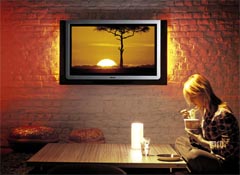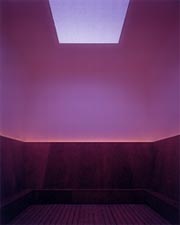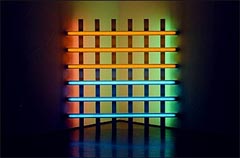Technology art is important for design
Technology art is a key incubator for ideas in interaction and industrial design. For me the chain of influence is clear: if design is the practice of making technology more human-centered, then art is the most pure expression of that idea. This doesn't mean that art is user-centered (it's not), and design shouldn't be treated as an art medium (as I've criticized critical design for doing), but art is made for people without the typical constraints that normally define the technology design process*. This makes it much more free to explore people's relationship to technology in ways that commercial products rarely can. I believe that it's critical that industrial and interaction designers look to art and artists for the results of their interpretations of the possibilities of technology and how they use art to identify important social and cultural phenomena.In this light, it's not surprising that the products of so many design programs (RCA, ITP and Interaction Ivrea) can be read equally as art and as technology and why the mixture on We Make Money Not Art has proven to be so popular. We can even trace the lineages: dodgeball.com is closely linked to flash mobs, which are a modern version of a 60s Happening. Flickr.com was created out of Game Neverending, which was as much a conceptual art piece as a game. There's almost certainly a relationship between Philips Ambilight TVs James Turrell's lighted color spaces, Dan Flavin's work and color field painting, too. (this leads to all kinds of interesting questions about intellectual property)



(Philips, Turrell, Flavin)
There's a lot of feedback between these worlds when the participants rub shoulders and explore each others' ideas: technologists can borrow ideas from artists and vice-versa. Jeff Bezos, the founders of Google, and countless other dotcom entrepreneurs used to go to Burning Man for more than the opportunity to wear funny outfits and dance all night long (though that kind of freedom is immensely valuable, too). Partly it was a generational thing--every generation's entertainment influences its view of the world, and the rave generation is no different--but it was a way to explore the idea of art, technology and experience without the normal intellectual shackles. The core that drives Google to not want to be evil and iRobot to include a geek port on the Roomba.is the same core that drives people to make technology into art. It's the ability to see beyond the technology to what it does for/to people and for/to the world. It's the core user-centered design philosophy.
The Bay Area is a major center of subversive technology art
The Bay Area has been an incubator of these relationships for close to 40 years. It starts with the technology-based architecture and art of Ant Farm and the Whole Earth Catalog's idea that technology can make the world better by being in average people's hands, not just formally-trained engineers'. That decentralizing ideas makes them more powerful (for a current technological instantiation of this idea, see BitTorrent). MAKE magazine is a direct descendant of that idea. The production of art, almost by definition, is decentralized and personal. Xerox PARC realized this back in the 80s, and Interval Research attempted to emulate PARC's model. Both famously failed to make the connections that, for them, showed the value in the practice, but it had lots of cultural value that's still resonating through the Bay Area technology world. The Survival Research Laboratories art collective's members play key roles in corporate research labs, like Xerox PARC and Intel Research.Also, critically, the Bay Area technology art scene has always been part of the counterculture. With no government or academic support, tech art in the Bay flourished for close to 40 years with few in any official capacity noticing. This gives it a unique flavor that's not just the expected (and certainly existent) hippie dilettante vibe that seems to be people's expectation. Tapping the Beats and Dada more than the hippies and Surrealism, SRL embodies depths of nihilism that can shock jaded New Yorkers. Ant Farm fetishized plastic, television and the Kennedy assassination.
The Bay Area is also home to an enormous amount of technology innovation and a major center of contemporary industrial design innovation. IDEO, which looms much larger in the industry than even their sizable portfolio of projects, and frogdesign, have their primary bases of operation in the Bay. I think it's no accident that the proximity of technology, art, subversive culture and optimism produces some of the best and most innovative products in the world.
This is, of course, not to say that all innovation happens in the Bay Area or that these things only exist in the Bay, but I believe that the mix is uniquely influential there. Other cities trying to create similar environments and design organizations thinking about what makes for good design should look toward the history of the Bay Area as a venue for subversive technology art, rather than just looking at the concentration of money on Sand Hill Road (though that's certainly important, too).
Three important technology art events
This summer there are three important events happening in Bay Area technology art that mark the movement of this field into the official sphere. We'll see how the culture changes, but right this is a key year in the recognition of this type of expression as important to the art world. It's as important, if not more, to design.- Frankenstein Theory and Robotics at RX gallery, open now, features a number of prominent Bay Area technology artists participating, though the title still betrays an unease with manipulating technology it correctly identifies the artists as explorers who have been laboring outside the academy.
- ISEA2006/ZeroOne San Jose, a festival that starts out as a twin festival and becomes a biannual one after this year. (the brand new biannual local festival, ZeroOne San Jose is using the established international festival, ISEA, as a kind of gravity slingshot). I'm a co-chair of the C4F3 and I'm really excited. Also, Anu Vikram, the producer of the C4F3 will be speaking at the RX Gallery next Wednesday about that show.
- Burning Man, which has been growing in official recognition, may well have made the leap this year. If you plan on going, old timers will probably tell you it jumped the shark when they laid out streets, installed portapotties and forbade people from carrying automatic weapons. Last year was the best year for years and it looks to be even better. Still totally worth it.
*=Yes, I realize that the art world is subject to economic pressures, too. In fact, I believe that the art world is a large, under-regulated market driven by huge amounts of insider trading and influence peddling, but my rant on the mythology of art as pure expression and the failure of art schools to teach students that it's a commercial practice will have to wait for another day. For now, there's this post that addresses some of the issues. My point in the above description is that it's not nearly as bound as client-driven design or market-driven development.
[Addendum: Liz points out that San Franciscan exceptionalism seems to have creeped into this post. That's probably true. I like San Francisco a lot and think it's special. I also acknowledge that despite its specialness and its stature as (what I believe to be) a center for the ideas behind technology, art, design and innovation, it has produced very few first-rate artists in the last 30 years. There are social reasons for that, too: art schools that didn't recognize what was going on around them, a seductive large art market in Los Angeles that siphoned off many promising artists, a community that valued creativity only inasmuch as it made for great eye candy while dancing, etc. However, I hope that's changing and that these exhibitions will signal the beginning of a shift in the environment.]



